
Welcome to the Visitor's Center at Brazos Bend State Park. That's me on a trail (03/29/2004). As I got more pictures, these pages expanded. I've gotten enough images of snakes
to collect them on my snake pages.
Snakes page 2 nonvenomous 2003 -2004 Snakes page 1 nonvenomous 2003 -2004
Snakes page 3 nonvenomous 2003 -2004 Snakes page 6 Rat Snakes 2002 - 2021
Snakes page 4 nonvenomous 2006 -2021
Snakes page 5 nonvenomous 2022 -2023
----------------------------------
Welcome
to the Visitor's Center at Brazos Bend State Park. That's me on a trail
(03/29/2004). As I got more pictures, these pages expanded. I've gotten enough
images of snakes
to collect them on my snake pages.
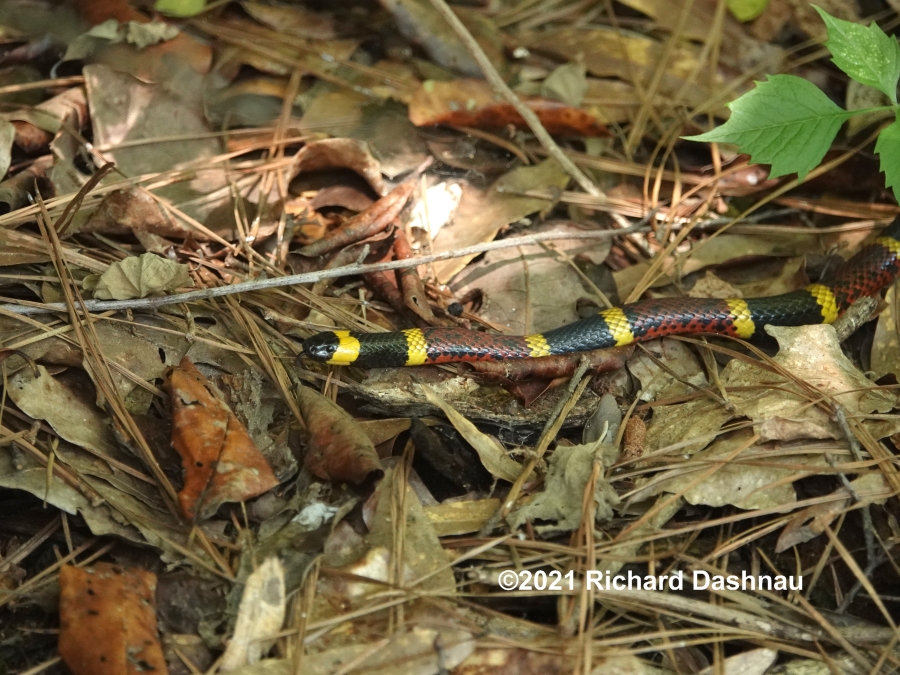
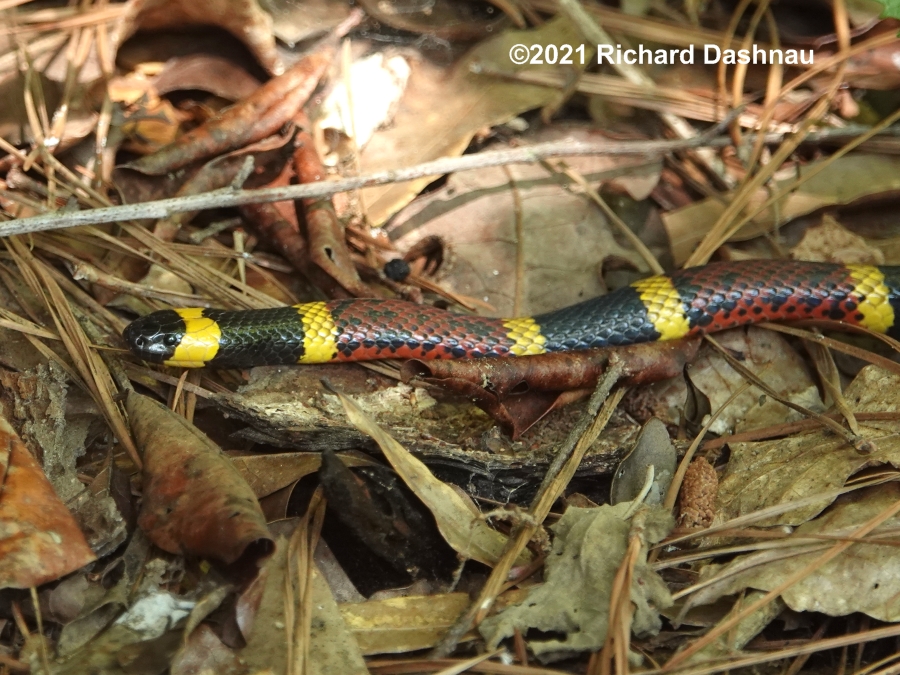
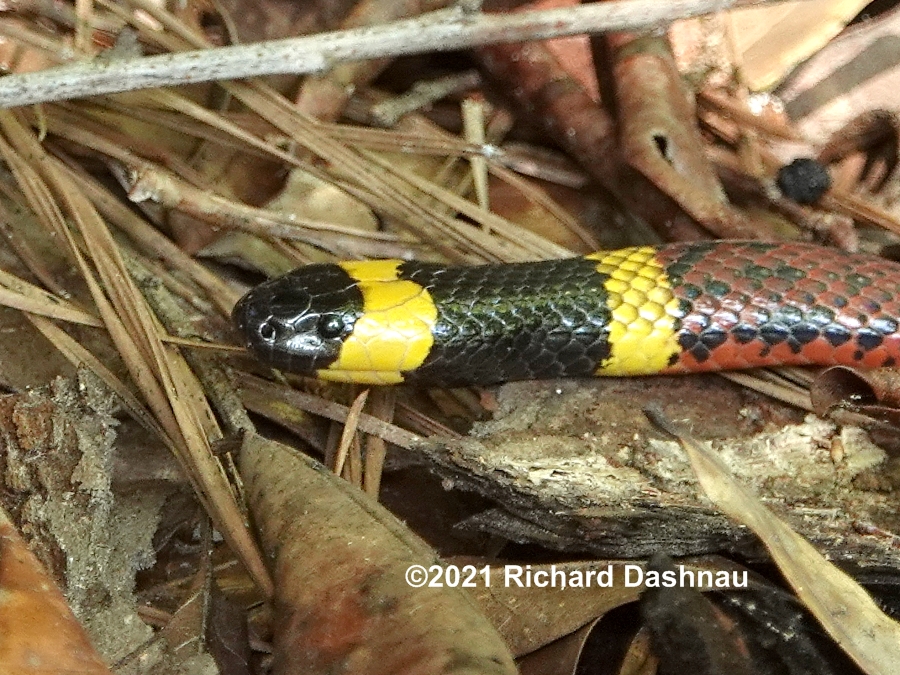
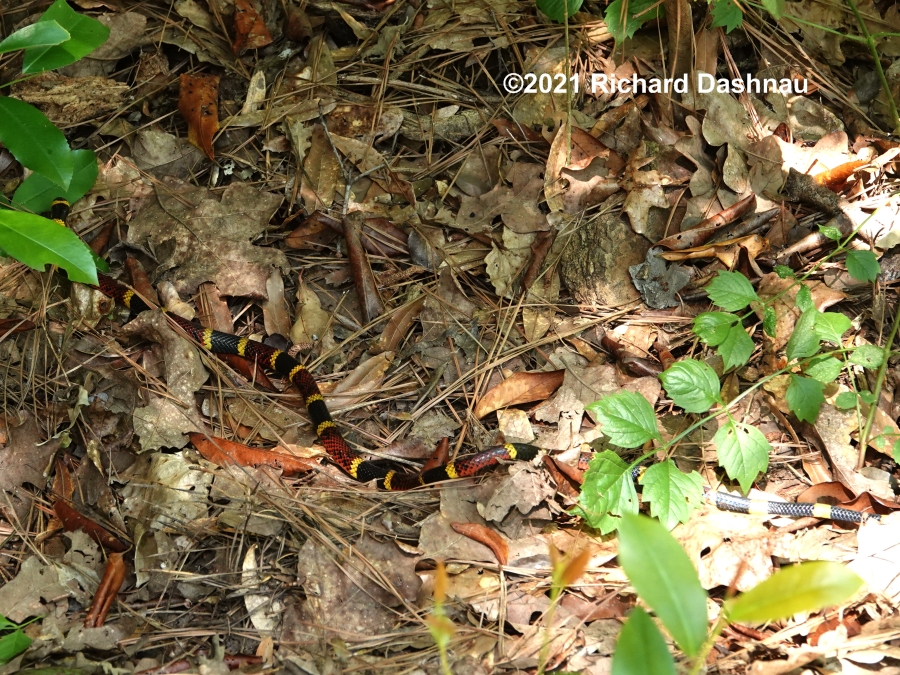
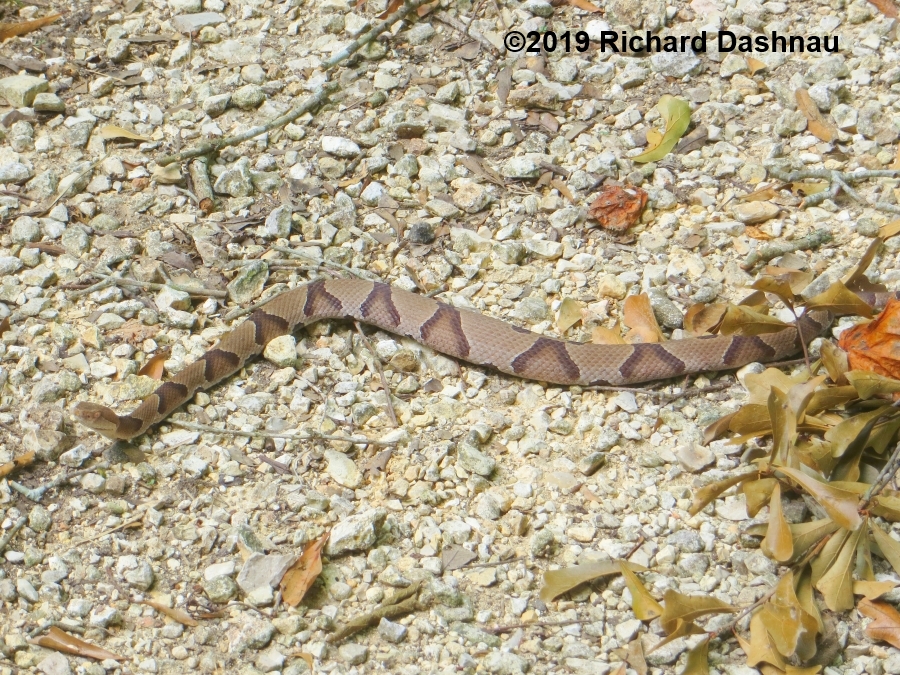
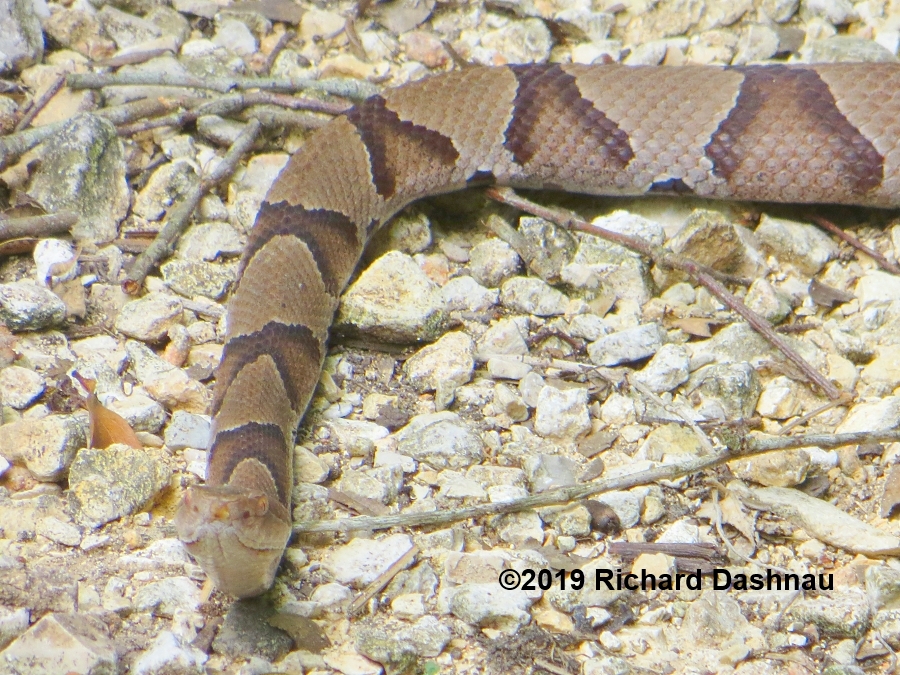

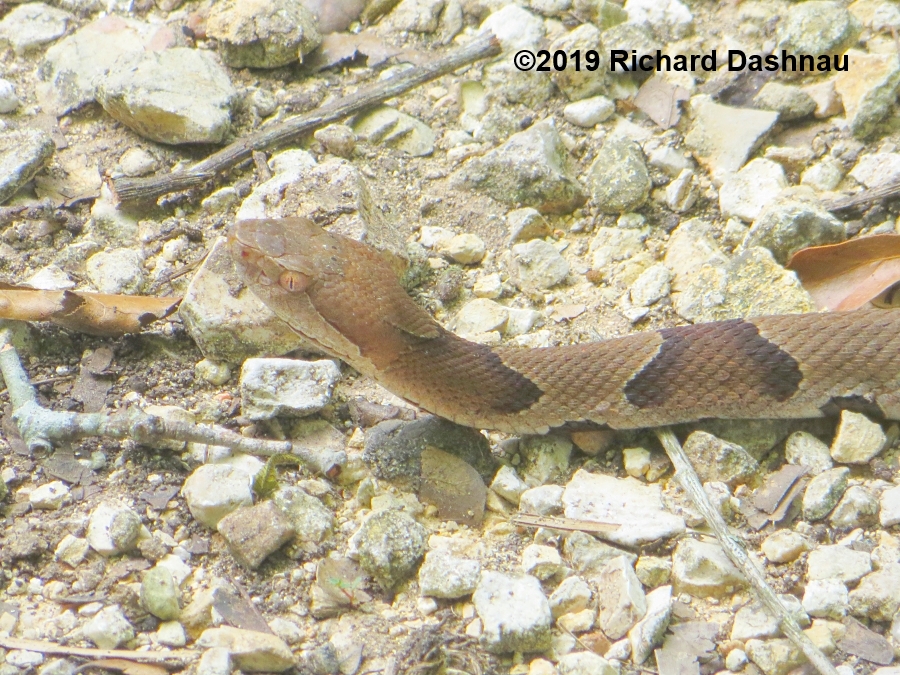
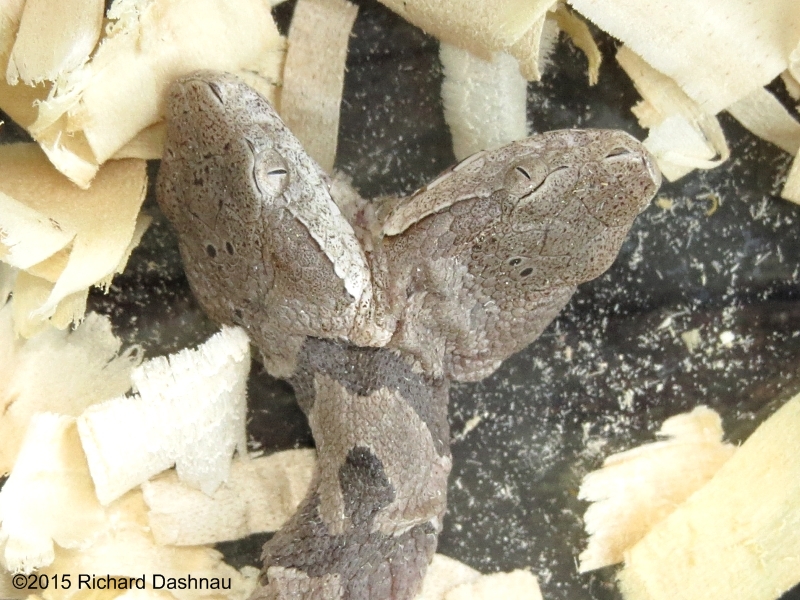 --
--12/21/2014 It's Near Christmas, and it was in branches...
I was driving back towards the Visitor's Center, when Chuck flagged me
down as he drove his truck in the other direction. He told
me of a
juvenile Copperhead that was hiding (in plain sight) up in some
branches, and he told me where it was. Some hours later, I went looking
for the snake on my way out of the park. And
I found it. The first
image below left is a composite of 3 shots showing the where the snake
was relative to the trail. The remaining images are views at various
zoom distances. I was very
impressed that the "leafy" camouflage
pattern seemed to work well among the branches 5 feet off the ground.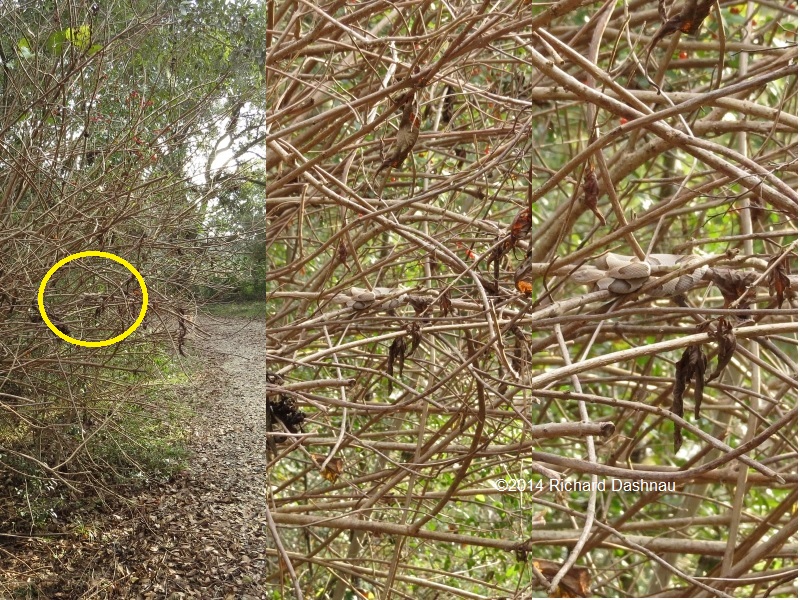
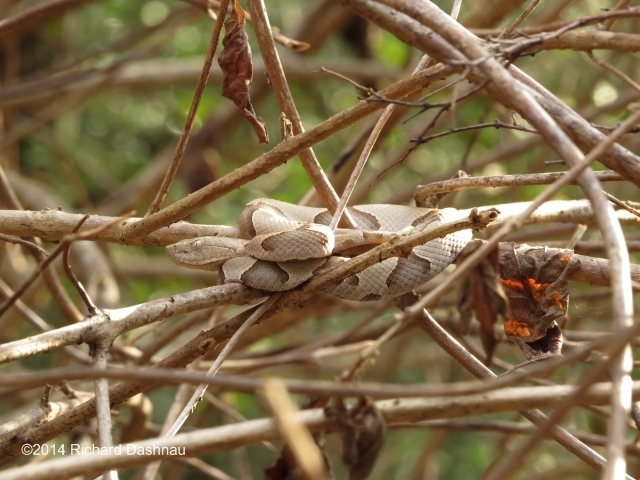
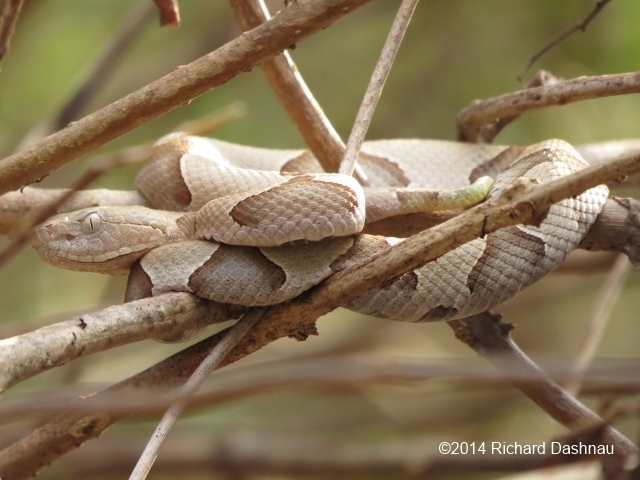
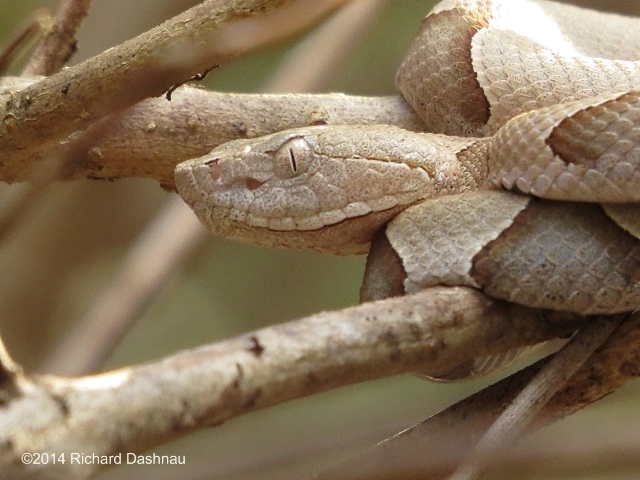
The
closest view shows the extra pit (near and just below the eye) and the
elliptical pupil that helps identify a pit-viper. I was stayed
relatively far from the snake, and it remained immobile
during my
photo-shoot. In the book How Snakes Work, by Harvey Lillywhite,
there is some discussion about the function for the colors of snakes.
(p129) Snakes that are marked with patterns
of blotches, spots, etc.
usually rely on concealment (called "crypsis" in the book) to hide from
potential predators. This copperhead is an excellent example of this. The
book goes on to say
that many (but not all) species that use "crypsis"
will aggressively defend themselves when their stategy doesn't
work-instead of trying to crawl away. This might be related to them
being unable
to crawl rapidly. Howver, the book goes on to say that
there are many exceptions to this. In the second picture, the
lighter (green or yellow) tail of the juvenile Copperhead can be seen.
As the
Copperhead gets older, the tail loses this lighter color. The
young Agkistrodons-Copperheads (A. contrortrix)and Cottonmouths (a.
piscivorous)-both have these lighter-colored tails. And, the
tails are
used in a behavior called "caudal luring". The tail can be used as
"bait" for prey for the snake--or as "bait" against a predator to
distract it from the snake's head. I have shot video
showing a juvenile
Cottonmouth using its tail as a distraction. Contrast this with
snakes that have stripes or similar uniform patterns. These tend to
rely on active escape by moving quickly away
from predators (p130).
This general behavior has been observed in a species of garter snake
that can have coloration that varies from striped to blotched. Striped
snakes tended to crawl away
when disturbed, while the blotched were
more likely to move a short distance and then stop completely. This
behavior is called a "reversal" and is used along with crypsis after
the snake has
been discovered. The movement and rapid stop can
confuse the predator; since it has been tracking movement, it appears
the prey has suddenly disappeared when the prey stops and blends
back
in. I assume that this is further aided by the tendency of the vision
to continue tracking along the percieved path of escape. I
have heard that this is how rabbits and deer can use the white
"flag"
of their tails as they escape a predator. They run, showing the tail,
then suddenly stop and hide their tail. Their natural color blends in
with the environment. Meanwhile, the predator has
been tracking a
white, high-contrast object through the woods which has suddenly
disappeared. The predator then has to bring their focus back along the
percieved track of their prey--which
has stopped moving, and will be
hard to see again. The striped (lines going head-to-tail) snakes
also have another weapon-optical illusion. (p130). Recognizing a moving
object and judging
its speed depends on the relationship of the color
pattern on that object and surface where it's moving. Striped snakes
can appear to be immobile even when they are moving--or can seem to
be
moving slower than they actually are. Since there is a continuous line,
it's hard to pick out a recognizable point, especially when the snake
is moving. I finally realized this after years of
watching snakes when
I watched it in action in a field. I recognized a ribbon snake in the
grass. I stopped moving, and looked down at a gap in the grass. I tried
to see the head, but wasn't sure
which way the snake was pointing.
While I was looking down at the snake I had thought was lying still;
the tail suddenly appeared in the gap--and the snake was gone. The
snake had been
moving all along! I have examples of 2 ribbon snake
moving. Exposed in high-contrast by being out in the open on a trail,
the movement can still mesmerize. The 2 images below are a screen
grab
from each clip. The links to the clips are here 051914wmv 051914mp4 and here 072014wmv 072014mp4.
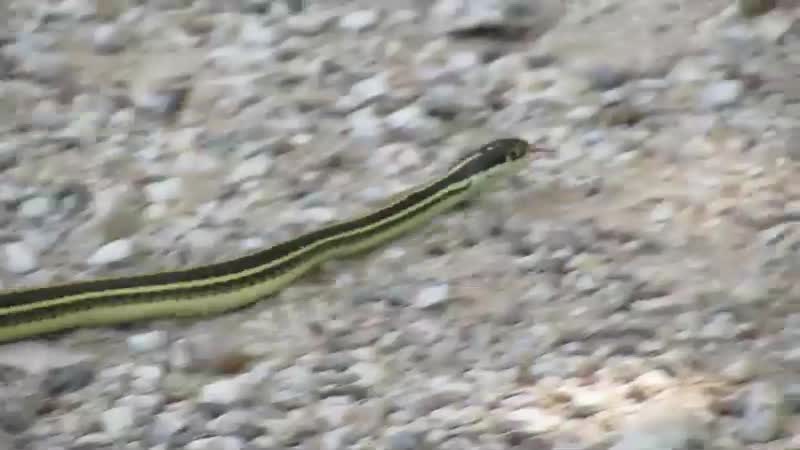
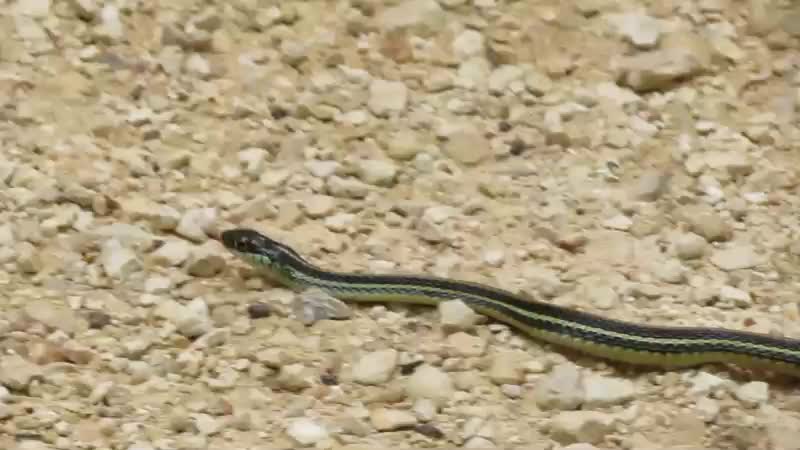
One
more thing is visible in the close views of the Copperhead. All of its
scales are not the same. Copperheads have "keeled" scales. These are
scales that have an additional ridge in their
center, that runs
lengthwise with the snake. Not all
snakes have keeled scales. Then, there are the broad scales that most
snakes have on their underside-which are called "scutes" (P.120)
Then, between the two types of scales, there is a line of
"transitional" scales, which don't have keels, but are not full scutes,
either. Since I gave no sign that the Copperhead's crypsis was
unsuccessful, it remained still; and I finally went home.
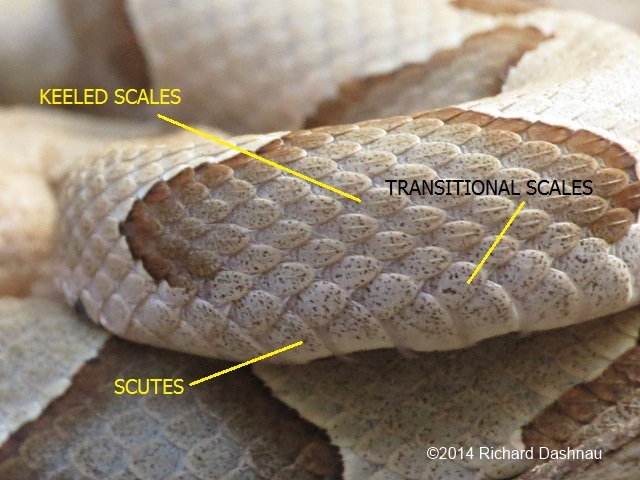
09/03/2006--I
had just started around the 40 Acre Lake Trail when I encountered a small
Southern Copperhead (Agkistrodon contortrix contortrix). I'd heard
it move through the leaves,
and when it stopped, I started taking pictures
of it. The first image below shows the snake looking up at me. (Also see
ONE and TWO, below. They are both are from the same image).
In image TWO,
the two heat-sensitive pits (which define the pit-vipers) are clearly visible.
The elliptical pupils are also visible. As I bent towards the snake (but
not very close at all), it
struck at me!
Since
the snake was acting so nervous, I decided to try to herd it off the trail.
Knowing that it would strike at least once more, I shot a short video clip
with my still camera
as I moved the stick closer to it. Images THREE and
FOUR below are single frames from this clip. The camera shoots video at
24 frames per second, non-interleaved. Even at that
speed, the snake's
strike is blurred. The links to the video clip is below. First is the clip
at actual speed. The other two clips are parts of the same clip digitally
slowed down to .2 normal
speed. (I'm assuming this is less than half normal
speed).
DEFENSIVE
STRIKES ACTUAL SPEED 2.5MB DEFENSIVE
STRIKES .2 SPEED A 1.8MB DEFENSIVE
STRIKES .2 SPEED B 3.1MB
To my
surprise, the Copperhead would not back down from me, but continued facing
me. This illustrates an important point. Most animals are content to be
left alone. Any animals enountered
on the various trails (like snakes or
alligators but also including deer or raccoons or other "cute" animals)
are generally on their way somewhere when they are discovered. If left
alone, they
will generally continue on their way. Sometimes a reptile will
pause to rest. If it is not ready to move, or, if it feels threatened;
then the animal may go into a defensive mode. In this case, it will
face
the enemy (which could be *you*, if you are bothering the creature); and
turn its defensive weapons towards the threat (you). Worst cases can be
fangs, teeth, or claws. Aside from the
"hard" weapons mentioned above,
there can also be various musks, urine, fecal matter, vomit, or various
other chemical weapons--this, of course, depends on the animal. The point
here is
that it's just best to leave the animals alone. In any case, these
weapons are intended to deter an attack.
The
only reason *I* was moving the snake was because it was obviously already
stressed, and I wanted it further away from the trail (and potential interaction
with park visitors. I finally persuaded it to move on, and I took
a few more photos. Images SIX, SEVEN, and EIGHT,
below, are three cropped
versions of the same image. While the snake has relaxed its body, you can
see it's still watching me. Remember--I
WORK FOR THE PARK. Do NOT molest, or catch,
or kill ANY snakes at the park.
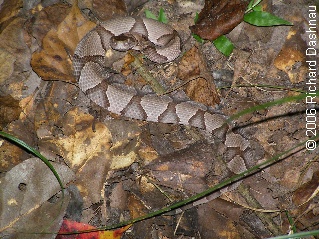 --
--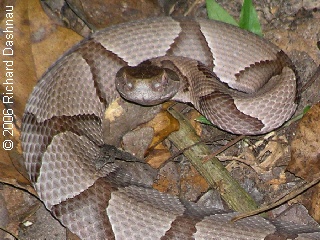 --
--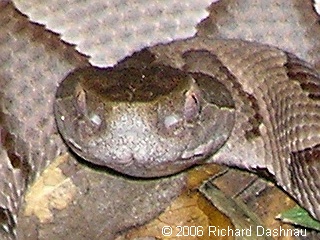 ----
----
SIX
SEVEN
EIGHT
The
picture below (SIX COPPERHEADS) is a picture of the other interesting item,
and to further clarify what the caption says, it's a good illustration
of "Why We Don't Put Our Fingers and Hands
into Places We Can't See."
This item, relayed to me by David-and discovered by Rich and Sandy Jesperson
and Carol Ramseyer I believe- was a group of six young copperhead snakes
under
a log.
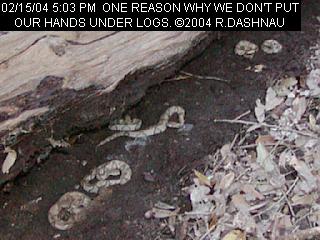 -
-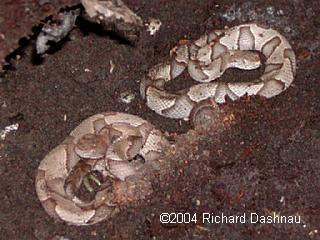 -
-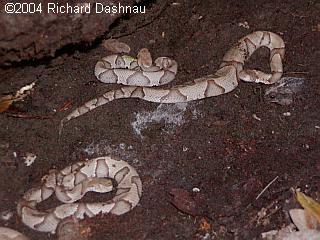
SIX COPPERHEADS
TWO ON THE LEFT
CENTER TWO
-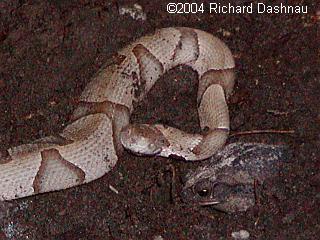 -
-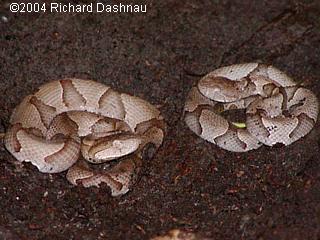 -
-
WE'RE JUST BUDDIES!
REALLY!
TWO ON UPPER RIGHT
After
looking at the alligator with its nutria, I went and looked for the log,
which turned out to be less than 5 minutes' walk from one of our parking
areas. CAREFULLY lifting the log (so I wouldn't
disturb, or crush
the snakes), I was very happy to see what I show in the pictures above.
They follow in sequence in the RICKUBISCAM image from lower left to upper
right, diagonally. Note the
extra little friend, a toad, lying next
to the center, extended snake (WE'RE JUST BUDDIES, above). The toad, like
the snakes, was seeking shelter from the cool weather, and is obviously
alive.
I estimate the snakes to have been between 8 and 10 inches long.
Since they are all curled-and I did this quickly to avoid disturbing the
snakes enough to make them move; and also before any
park visitors might
come along-there was no way I could measure them. My usual use of a quarter,
or any other method of measurement that would require me to put my hand
near the snakes
was not an option.
Now,
remember this lesson. You can never be certain of what is under any large
object you might find in the woods. It could be one snake,
which may or may not be
venomous, or it could be SIX snakes, which may
or may not be venomous. In this case-copperheads-they were all venemous,
and if someone reached under this log to lift it, they could have been
bitten at least six times (more, if any of the snakes struck more than
once). If you must move something, then use something that won't be injured
if it is bitten or stung. Remember that in a State
Park, it is against
the law to disturb or harass the wildlife (this includes snakes). This
is also why it is best to stay on the trails at all times. So, if you are
using a State Park as you should, then this
situation shouldn't even occur.
-----------------
-------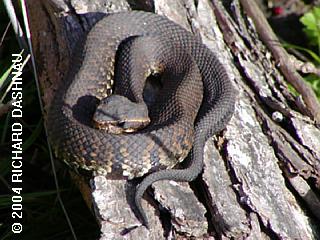 -------------------
-------------------
ONLY DANGEROUS IF YOU BOTHER IT
------------------------------------------------------------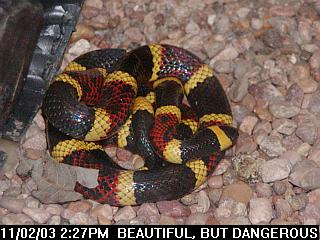
BEAUTIFUL!
After
today, it will be released in a secluded section of the park, to live free
once again. Coral Snakes like to eat small lizards, amphibians, and other
snakes. Unlike the snakes that we do keep
in the VC/NC, Coral Snakes
don't do well in captivity. In the picture below (RED TOUCH YELLOW) you
will see the color scheme that will warn you that this is the venomous
Coral Snake. The
bands of yellow touch directly on the bands of red. The
black "patches" in the red bands help distinguish it from the Eastern Coral
Snake. Note also in the picture of its head (CORAL SNAKE
HEAD, below)
that the head is very small, and the eyes aren't very prominant. Do not
be misled by the apparent size of this creature. Regardless of the size
of its head, like *any* snake, the Coral
Snake can open its mouth wide,
and the poison it produces is a potent neurotoxin (Coral Snakes are in
the same family as Cobras and Mambas). Compare the color scheme with
that of a
Mexican Milk Snake (Lampropeltis triangulum annulata) (see RED
TOUCH BLACK, below); one of many non-venomous snakes species that mimic
the Coral Snake's color scheme. This
particular snake is not native to
our vicinity, though. Notice that the bands of red touch directly on the
bands of black (unlike the Coral Snake, where red touches yellow). This
is true for all of the
various species of non-venomous King and Milk snakes
that have this similar color pattern. A look at the Milk Snake's
head (see MILK SNAKE HEAD, below) will show that the head is a bit larger
in relation to the body, and the eyes are much more prominent, than with
the Coral Snake. Also notice that I am holding the Milk Snake (yes,
that's
my left hand), and definitely *not* the Coral Snake.
Both
snakes are beautiful, aren't they? Yes, they are. Both eat small reptiles,
including snakes, as well as other small animals; although the Milk Snake
will also take rodents, while evidently the
Coral Snake does not.
Finally,
here
(flv video 552 kb) is a short video clip of the Milk Snake exploring
my hand. This snake has been with the park at least for the two years I've
been there, and is
obviously used to being handled. The image below (MILK
SNAKE VIDEO) is a single frame from the beginning of the clip. Incidentally,
the Mexican Milk Snake is not found in our park (its range
is more
Central Texas), but is kept there to show an example of this mimicry. Animals
will sometimes try to emulate the shape and/or color of a similar species
that is more dangerous; so that
predators may leave them alone.
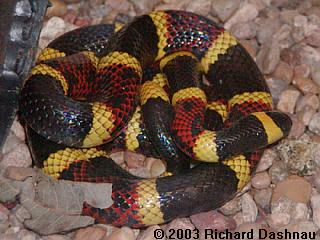 -
-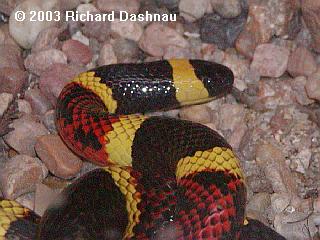 -
-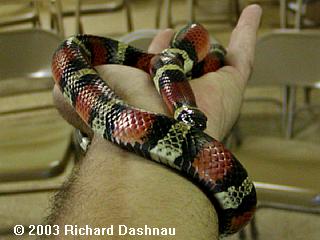
RED
TOUCH YELLOW
CORAL SNAKE HEAD
RED TOUCH BLACK
-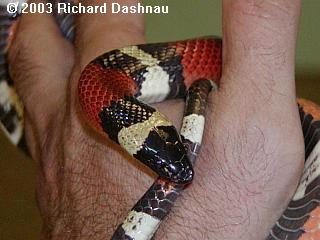 -
-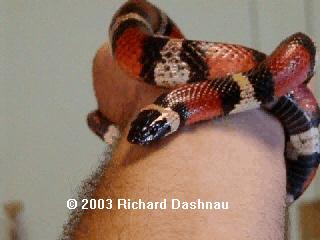
MILK SNAKE HEAD
MILK SNAKE VIDEO
----- -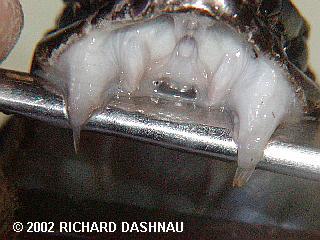 ---------
---------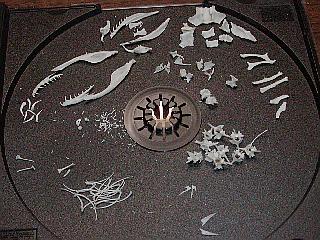 -------------
-------------
3 FANGS BEFORE
WHERE'S THE INSTRUCTION MANUAL?
September
22, 2002Suppose
for a moment that you have just pulled into Brazos Bend State Park, and
as you enter the park, your brain registers the image of an upside-down
snake on the side
of the road. You drive past, as your mind catalogs the
event. What do you do next?
Well....I
drove a second or two more, and then thought: "Interpretive Material!",
and I stopped the car (after, of course,
being sure there was no one behind
me.) I then backed up, and passed the snake again. After retrieving
one of my Tallow-Whacking machetes from the rear of my car, I moved towards
the snake.
After carefully prodding it over, I saw that it was a
Water Moccasin, or Cottonmouth (agkistrodon piscivorus), and that it was
dead. This was easily determined by noticing that it had already been found
by fire ants, and NOTHING will sit still while being attacked by fire ants.
This snake is one of 3 pit-vipers that used to be found in the park (the
Canebrake Rattlesnake is thought to be extinct in the park),
and is
venomous. The head was intact, so I cut it off and slipped
it into a small plastic container (film case) that I had in my car for
just such an occassion. Then I put the case into my vest pocket (well
THAT'S
what the pockets are FOR!).
Later
examination of the head while photographing it revealed a few things. The
image below shows a side view of the head as I hold it between my fingers.
(NOTE
THAT I USED EXTREME CARE WHILE HANDLING THIS SPECIMEN, EVEN THOUGH IT WAS
DEAD! ALSO NOTE THAT THIS SNAKE WAS ALREADY DEAD! I'D NEVER
CONSIDER KILLING
*ANY* SNAKE IN THE PARK.)
---------------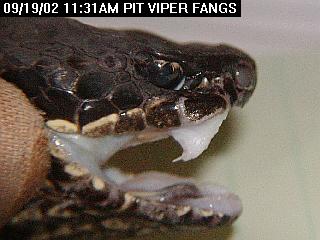
Pictures
below show: The extended fangs (MOUTHOPEN1); Closeup of both fangs (MOUTHOPEN2);
the right fang (RIGHTFANG1). As I was pushing on the fangs for these
pictures, I noticed fluid
appearing on the fang. I assume that this was
venom I was forcing from the poison sac (RIGHTFANG2). THIS
IS WHY CARE IS NECESSARY WHEN HANDLING DEAD VENOMOUS SNAKES.
The
teeth are like needles, and a slip on my part could cause an injection.
Some
sharper-eyed people may have noticed something odd in the first two pictures.
The left fang is is a double fang! This
picture (LEFTFANG1) shows a closeup
of that structure. David, the park naturalist, says that from time to time,
the snake will grow a replacement fang. As this grows, it moves alongside
the previous
one, until the older one finally drops off. If I'd thought
about it, I could have tried to force venom out, to see which fang it would
flow from. But...I didn't think about it, so it's unknown to me.
Oh, well, I can't
think of *everything*. In any case, visitors to
this page can now say that they've actually seen pictures of a three-fanged
Water Moccasin!
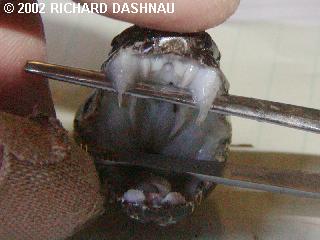 -
- -
-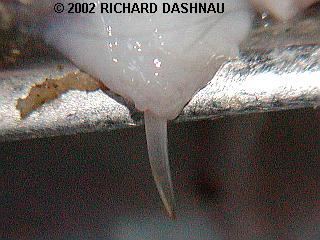
MOUTHOPEN1
MOUTHOPEN2
RIGHTFANG1
After
all this, I began a treatment of the head which I hope will allow me to
strip the flesh off and maintain enough structure for me to rebuild the
skull--WITH the double fang. That will be an interesting
display!
Please
note that like all animals in the park, the snakes, including the venomous
ones, are part of the ecology. They perform a function like *all* predators.
They are harmless to humans when
left alone (to their PREY, on the other
hand, they are BIG TROUBLE). Care should be taken while walking in
*any* wild area for a number of reasons. The great majority of the
snakes in the park are
non-venomous. The presence of these-and any other-reptiles
in the park should be no cause for alarm. Brazos Bend State Park
is an amazing and unique natural resource and an area with a
varied number of animal and plant species. On a single good day at
the park, it is possible to see as many wild creatures as most people
would see in a year...or even in a lifetime.
On the other hand, if
the interpreters (like me) at the park do what they hope to do, then
visitors who leave the park will see more wildlife everywhere.
Because they'll start to notice it!
May
05, 2002 Tuesday,
April 23, I got to the park around 8:00 am. I hadn't been on the trail
10 minutes (I started at the 40-Acre Lake parking lot), when I encountered
a
copperhead stretched across the trail near Hoot's Hollow. I
was able to take a few pictures before it got bored with me and continued
across the trail.(COPPERHEAD,
above) Notice the coloration
of the scales and the shape of the head. Also, the nostril is the small
opening at the tip of its nose. You might notice another opening between
the nostril and the eye. This pit is what gives "pit vipers" their name.
It's a heat sensor, and aids the snake in stalking food. Copperheads are
poisonous, and as stated in
signs throughout Brazos Bend State Park, "POISONOUS
SNAKES EXIST IN THIS PARK". The snakes belong in the park. Humans
are only visitors there. Visitors should
keep a close eye on their children
and pets while they are in the park, for this reason.
Snakes page 2 nonvenomous 2003 -2004 Snakes page 1 nonvenomous 2003 -2004
Snakes page 3 nonvenomous 2003 -2004 Snakes page 6 Rat Snakes 2002 - 2021
Snakes page 4 nonvenomous 2006 -2021
Snakes page 5 nonvenomous 2022 -2023
Go back to my home page, Welcome
to rickubis.com
Go
back to the RICKUBISCAM page.